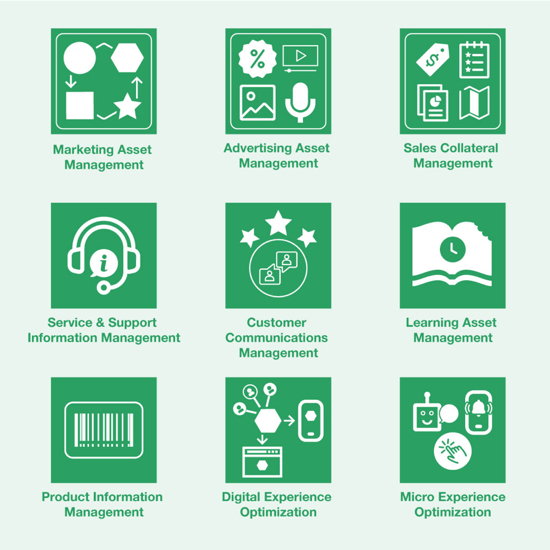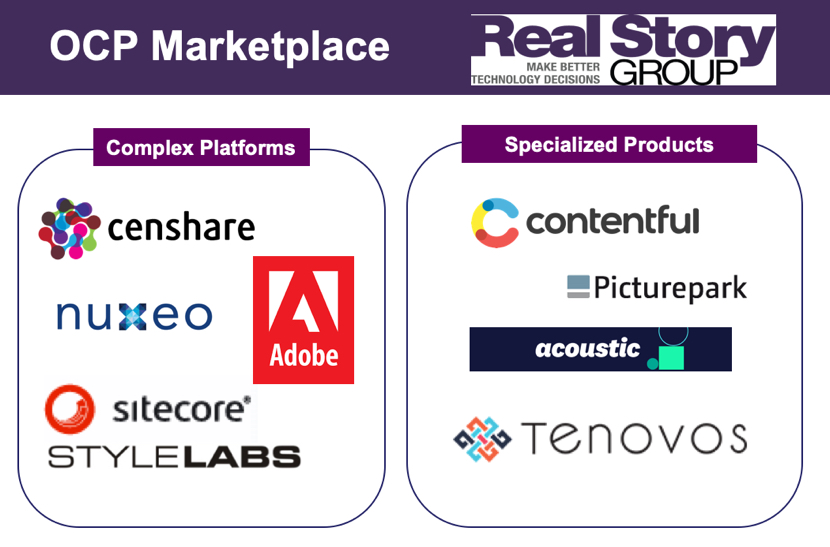This article appears in the Fall-Winter 2019 digital issue of DOCUMENT Strategy. Subscribe.

Over the past few years, we’ve seen the rise of a new category of platforms that are designed to supply core content to the ever-growing channels of customer engagement. After extensive research here at Real Story Group, we’ve labeled this modern class of tools as omni-channel content platforms. Emerging primarily from the digital asset management (DAM) arena, some key technologies have also spun off from the headless web content management and marketing asset management markets.
Omni-channel content platforms try to solve the problem of divergent customer experiences and messaging when content gets tightly bound to a specific engagement channel, like your website, email platform, sales force automation platform, or customer support portal. Omni-channel content platforms can provide the infrastructure for process efficiencies and messaging consistency, but they also fuel more personalized customer experiences.
 As you’d find with most marketplaces, the typical omni-channel content platform vendor will only excel at three or four use cases, so it’s really important to prioritize your most important business objectives when considering these tools. Also, in some cases, the omni-channel content platform will deliver those services. While in other cases, it will just provide the core content building blocks to be assembled somewhere else by a third party or other channels.
As you’d find with most marketplaces, the typical omni-channel content platform vendor will only excel at three or four use cases, so it’s really important to prioritize your most important business objectives when considering these tools. Also, in some cases, the omni-channel content platform will deliver those services. While in other cases, it will just provide the core content building blocks to be assembled somewhere else by a third party or other channels.
Derivation is an important feature in an omni-channel world where context often gets set at the edge of the customer experience. For example, you may modify a core re-usable video snippet differently for Facebook than for Twitter, let alone a partner website. The omni-channel content platform needs to track these derivations so that, for example, when the core “parent” asset gets modified, downstream “children” owners get notified.

It’s worth elaborating on a few of the suppliers:
First up, Acoustic Content is the successor to IBM’s Watson Content Hub—one of Big Blue’s newer offerings but sold off earlier this year to a private equity firm, along with the rest of IBM’s MarTech portfolio, and has now been renamed.
Then there's Sitecore Content Hub, which is a rebrand of some cloud-based tooling acquired from Belgian vendor Stylelabs in 2019.
Adobe’s solution rather uneasily straddles two different platforms: AEM Sites and AEM Assets.
Lastly, Nuxeo is a longstanding ECM vendor that dallied in the DAM market in recent years, picking up omni-channel content platform capabilities along the way.
This space is also expanding rapidly, as enterprises pay more attention to customer experience across channels. Along with analog solutions for core customer data (customer data platforms) and decision/rule engines (journey orchestration engines) at an enterprise-wide tier, omni-channel content platforms that unify the management, delivery, and tracking of reusable information assets will become increasingly important.

Image by: Blankstock, ©2019 Getty Images
While many industry pundits have focused on traditional enterprise content management (ECM) vendors transitioning from document management to content services platforms, a parallel, and potentially a more interesting, trend has been taking place in the customer experience (CX) world.
Over the past few years, we’ve seen the rise of a new category of platforms that are designed to supply core content to the ever-growing channels of customer engagement. After extensive research here at Real Story Group, we’ve labeled this modern class of tools as omni-channel content platforms. Emerging primarily from the digital asset management (DAM) arena, some key technologies have also spun off from the headless web content management and marketing asset management markets.
Business Use Cases
The purpose of an omni-channel content platform is to act as a single source of truth for a highly curated set of reusable enterprise-wide information assets, such as text, data, and media. An omni-channel content platform manages and distributes the core assets of an enterprise—not all assets, but a select subset needed to provide consistent customer experiences across channels.Omni-channel content platforms try to solve the problem of divergent customer experiences and messaging when content gets tightly bound to a specific engagement channel, like your website, email platform, sales force automation platform, or customer support portal. Omni-channel content platforms can provide the infrastructure for process efficiencies and messaging consistency, but they also fuel more personalized customer experiences.

9 Use Cases for Omni-Channel Content Platforms
Source: Real Story Group Vendor Evaluations
Underneath the Omni-Channel Content Platform Covers
At their core, omni-channel content platforms are component content management systems. However, unlike the technical documentation platforms of the past, they’re built for the media era. In fact, a key design principle is that text, media, and data are all first-class objects. Contrast this with more traditional approaches where, for example:- In documentation systems, images remain bound to text
- In most ECM and DAM platforms, structured text and data are subsidiary extensions to files, rather than independent objects themselves
The key word here is “object.” In order to support complex data models with compound assets and sophisticated where-used analysis, an omni-channel content platform needs to be object-oriented, both in code and repository. This is why most of them are built on graph-type datastores.
What gets managed in those datastores? In order to support specific business scenarios around aggregating assets into specific experiences, an omni-channel content platform needs to support content at an atomic, component level. The types of component assets could include:
What gets managed in those datastores? In order to support specific business scenarios around aggregating assets into specific experiences, an omni-channel content platform needs to support content at an atomic, component level. The types of component assets could include:
- Micro-content (e.g., offer copy, email blocks, or text messages)
- HTML micro-experiences (e.g., widgets)
- Document assets (e.g., PowerPoint decks)
- Digital assets (e.g., infographics)
- Video assets (e.g., short video snippets)
- Audio assets (e.g., podcasts)
- Data assets (e.g., coupon codes, pricing, offers)
Derivation is an important feature in an omni-channel world where context often gets set at the edge of the customer experience. For example, you may modify a core re-usable video snippet differently for Facebook than for Twitter, let alone a partner website. The omni-channel content platform needs to track these derivations so that, for example, when the core “parent” asset gets modified, downstream “children” owners get notified.
The Omni-Channel Content Platform Marketplace
This is a small, but growing, marketplace. Like most emergent technology markets, you can roughly divide omni-channel content platform offerings into more extensible and complex platforms versus simpler or specialized products.
Omni-Channel Content Platform Marketplace, Q4/2019.
Source: Real Story Group
It’s worth elaborating on a few of the suppliers:
First up, Acoustic Content is the successor to IBM’s Watson Content Hub—one of Big Blue’s newer offerings but sold off earlier this year to a private equity firm, along with the rest of IBM’s MarTech portfolio, and has now been renamed.
Then there's Sitecore Content Hub, which is a rebrand of some cloud-based tooling acquired from Belgian vendor Stylelabs in 2019.
Adobe’s solution rather uneasily straddles two different platforms: AEM Sites and AEM Assets.
Lastly, Nuxeo is a longstanding ECM vendor that dallied in the DAM market in recent years, picking up omni-channel content platform capabilities along the way.
The Future of Omni-Channel Content Platforms
Omni-channel content platforms will likely not replace your existing content management systems—but co-exist with them. Like many omni-channel services, an omni-channel content platform becomes an enterprise-wide layer underneath your other content and engagement platforms. As such, you should remain suspicious about any existing content/asset management solution in your stack playing this role. You’ll find them either too bound to a specific engagement channel or too restricted in terms of information types and model extensibility.This space is also expanding rapidly, as enterprises pay more attention to customer experience across channels. Along with analog solutions for core customer data (customer data platforms) and decision/rule engines (journey orchestration engines) at an enterprise-wide tier, omni-channel content platforms that unify the management, delivery, and tracking of reusable information assets will become increasingly important.
Tony Byrne is Founder of Real Story Group, an exclusively buyer-focused analyst firm that helps marketing technology and customer experience stack leaders make the right decisions. Contact Tony at tbyrne@realstorygroup.com or visit www.realstorygroup.com.
















